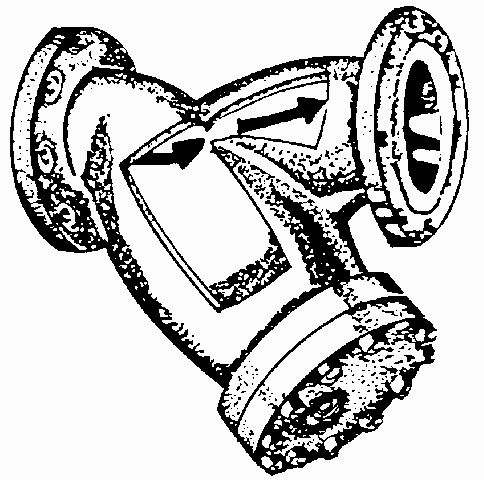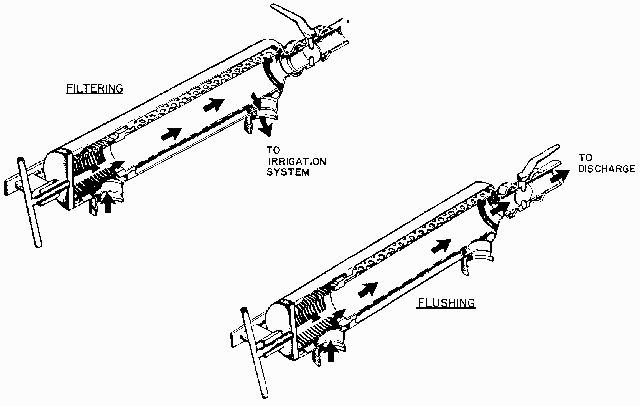Screen Filters in Trickle Irrigation Systems
Trickle irigation is a system by which water is applied at low rates and high frequency to the root zone of a crop. In addition, water soluble nutrients and other chemicals can be delivered with irrigation water at rates close to the plant requirement. When well managed, trickle irrigation will result in water, nutrient, and energy savings due to its low operating pressure and high emission uniformity (when compared to the other pressurized irrigation systems). However, trickle irrigation usually require a higher level of management than other irrigation systems.
Water quality is a major concern in the management of trickle irrigation systems. Emitters plugged by physical, chemical, or biological contaminants may create significant problems in everyday maintenance. Therefore, effective and reliable filtration is mandatory for successful operation of trickle irrigation systems.
There are different types of filters available for the removal of physical contaminants from irrigation water. Selection of a filter depends on the type and amount of contaminants in the irrigation water, as well as the size of the irrigation system and the desired management practices. Various types of screen filters are commonly used in irrigation systems.
Screen Filters
Screen filters are simple and economical filtration devices of various shapes and sizes, most frequently used for the removal of physical contaminants. They can be made of metal, plastic or synthetic cloth enclosed in a special housing (Figure 1). Screen filters are recommended for the removal of very fine sand or larger-sized inorganic debris. It is normally not effective to use screen filters for the removal of heavy loads of algae or other organic material, since filters clog rapidly, requiring too frequent cleaning to be practical.

When surface water is used for trickle irrigation, screens are often used as secondary filters, after organic matter has been removed with media filters. In this capacity they prevent washed out media from entering the irrigation system. When well water is used for irrigation, a screen filter may be used as a primary filter, or it may be secondary to a vortex sand separator, depending on the mineral particle load in the water.
Screen Sizes
Filtering screens are classified according to the number of openings per inch, with a standard wire size given for each screen size (Table 1). The minimum size of particle retained by a screen filter with a certain mesh can be determined from Table 2. A 200 mesh screen is used often in trickle irrigation. Water filtered with a 200 mesh screen will contain only particles of very fine sand or particles of even smaller sizes (Table 2).
Generally, it is recommended to remove particles down to a size four times smaller than the emitter's passageway so that grouping and bridging of particles will not cause clogging. The maximum tolerable particle size for a given emitting device should be provided by the manufacturer. Organic particles with a density approaching the density of water tend to group and bridge more easily. Particles heavier than water, typically mineral particles, may settle and collect in the low flow zones of the irrigation system.
Selecting a Screen Filter
When estimating the appropriate size of filter for a specific application, one should consider the quality of water needed, volume of water required to be passed through the filter between consecutive cleanings, filtration area of the filter screen, and allowable pressure drop through the filter. A screen filter can handle a large range of discharges. However, discharges that are large in relation to the filtering surfaces will result in greater pressure losses, shorter life of the filter, and the requirement for frequent cleaning.
The size of the filter is specified by its effective area, which is the area of the openings in the screen. It is specified in relation to cross-sectional area of the man pipe. A desirable ration is 2 or more (area of openings much larger than the cross-sectional area of the pipe). The mesh size of the filter (opening size) will depend on the smallest particle size to be removed from the irrigation water.
If the irrigation water contains large amounts of sand or other inorganic contaminants, it is advisable to use vortex sand separators before the screen filters. Vortical water flow separates heavier particles away from the fine mesh cartridge. They collect at the bottom of the filter, where they can be periodically flushed away.
Gravity Screen Filters
Gravity screen filters operate on the principle of gravity force, not water pressure. Because only atmospheric pressure is used, soft organic material is not forced through the screen.
Gravity screen filters are often used where an elevated water source from the canal or reservoir is available. Since the pressure loss through a gravity screen filter is very small, they are often used in systems where such losses must be minimized.
Gravity screens are easy to install and maintain. Usually, these filters are constructed as two chambers separated by a fine mesh screen, which can be cleaned manually or automatically (Figure 2). However, most of them incorporate self-cleaning water jets.

Intake Screens
If water is pumped from a surface source (lake, pond, stream, river, irrigation canal or pit), aquatic plants, fish, and animals should be kept away from the intake pipes. This can be accomplished with an intake screen (Figure 3 and Figure 4). The design of the screen must allow for the separation of the debris from the water without pulling the debris against the screen. Use a horizontal screen placed below the water surface or an intake basket-type filter.


The efficiency of pumping may be reduced by debris in the water entering the suction pipe. The problem can be solved by using intake screens. Some of these screens are self-cleaning and require very little maintenance.
Y-Type Strainers
Small amounts of larger particles, such as limerock flakes from the Florida aquifer, can be removed using a Y-type strainer with replaceable screens and with clean-out faucets or valves (Figure 5). They can be flushed while in use if the required high flow for flushing is provided.

Blowdown Screen Filters
Blowdown filters operate in the same way as other types of pressure screen filters. They are designed for easy cleaning, which is done by opening a valve that diverts the water flow through the screen, releasing trapped particles (Figure 6). Occasionally, blowdown filters require manual cleaning to eliminate particles that have become lodged in the screen.

Cleaning Screen Filters
Screen filters can be cleaned manually by removing the screen and washing it with clean water. However, dismantling is not very practical for use with waters containing high levels of contaminants, since it must be done often. Blowdown screen filters greatly simplify the cleaning process. They are cleaned with the water diverted through the screen by opening a valve. This operation does not require disassembling. The screen does not have to be removed for routine cleaning of the filter, but it must be removed for occasional cleaning of the particles which become lodged in the screen.
The most convenient method for cleaning screen filters is automatic screen flushing triggered by critical pressure differential across the filter, which increases with buildup of debris on the screen. Automatic cleaning can also be set on a time schedule.
It is very important to prevent particles from entering the irrigation system during cleaning. Even small amounts of organic or inorganic contamination may be sufficient to clog a trickle irrigation system. Filtered water is recommended for washing and backflushing. Additional safety devices such as secondary screen filters at the entrance to each irrigation system subunit are highly recommended.
Disk Filters
Disk filters are relatively new types of filters which can replace screen filters in trickle irrigation systems. The filtration element consists of a stack of grooved metal disks coated with epoxy and placed on a telescopic shaft inside the housing (Figure 7). Water flows through the disks from the outside inwards along the radii of the disks. Particles suspended in the water are trapped in the grooves of the disks, and clean water is collected in the center of the disks.

Disk elements can be manually or automatically cleaned. During manual cleaning, the housing is removed, the telescopic shaft is expanded, and the compressed disks separated for easy cleaning. They are normally cleaned by rinsing with a water hose. The telescopic shaft prevents the individual disks from falling off the shaft during rinsing. Automatic backflushing is triggered by the preset pressure differential. This pressure differential opens the exhaust valve and water flows backwards through the disks, removing trapped particles from the grooves.
Summary
Screen filters are the most popular filtering devices used in irrigation systems. They are commercially available in many shapes, sizes, and screen meshes. Screen filters are primarily recommended for the removal of inorganic material, such as sand and scale. They should not be used as the only filtration system in the presence of organic contamination. In that case they should be used as secondary filters following media filters.
References
ASAE Engineering Practice: ASAE EP405 - Design, Installation, and Performance of Trickle Irrigation Systems. 1984. Amer. Soc. Agric. Engr. St. Joseph, MI.
Boswell, M.J. Hardie Irrigation Design Manual. 1984. James Hardie Irrigation. Laguna Niguel, CA.
Finkel, H.J. CRC Handbook of Irrigation Technology. 1982. CRC Press, Inc. Boca Raton, FL.
Goldberg, D., B. Gornat and D. Rimond. Drip Irrigation Principles, Design and Agricultural Practices. 1976. Drip Irrigation Scientific Publications, Kfar Shmaryahu, Israel.
Jensen, M.E. Design and Operation of Farm Irrigation Systems. 1980. Amer. Soc. Agric. Engr. St. Joseph, MI.
Karmeli, D., J. Keller. Trickle Irrigation Design. 1975. Rain Bird Sprinkler Manufacturing Corporation. Glendora, CA.
Zazueta, F.S., A.G. Smajstrla and D.S. Harrison. "Glossary of Trickle Irrigation Terms." 1984. Agric. Engineering Fact Sheet AE-45. University of Florida.


